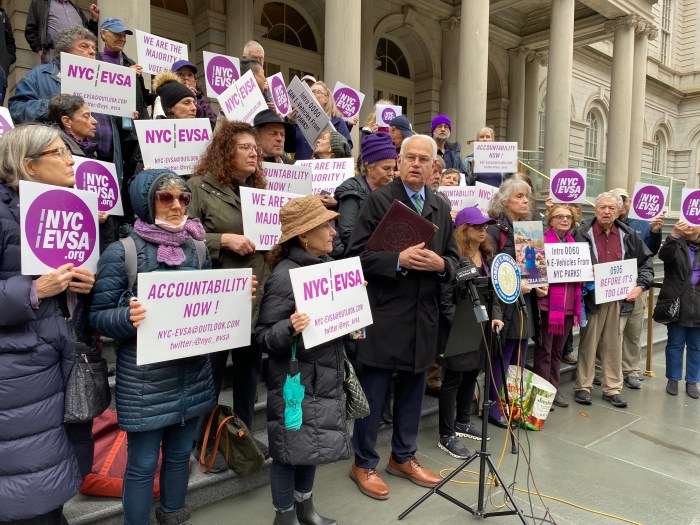The MTA has found 191 instances of malfunctioning subway signal timers that could be contributing to trains unnecessarily slowing down, according to MTA officials.
The timer signals, which the MTA deploys as safety devices to ensure train operators follow speed restrictions, were found to not be properly clearing trains and to be enforcing incorrect speed limits on the tracks.
Those faulty timers have led to a distrust of the equipment among train operators, some of whom say they opt to travel as much as half the designated speed limit in order to ensure that they do not trip a malfunctioning timer. If they do, their trains grind to a halt — emergency brakes are activated — and the operators could face a loss of pay. Meanwhile riders are stuck suffering from late and unreliable service.
“Imagine that you’re driving and there’s a speed limit posted at 50 mph, but it turns out you’re getting pulled over for going 35,” said Seth Rosenberg, who has worked as an MTA train operator for 11 years. “Instead of being able to follow the rules and know exactly what’s going to happen, every signal is different and it makes operating slower and more stressful.”
The MTA began testing the accuracy of its timers in late August as part of Transit President Andy Byford’s “Save Safe Seconds” campaign that aims to speed up train trips by improving basic elements of service. So far, the authority has tested about 90 percent of the roughly 2,000 signal timers in its first systemwide review of the devices, according to Barry Greenblatt, the MTA’s vice president and chief officer of service delivery.
Workers say that navigating faulty timers has become part of the culture at the MTA, where supervisors advise new hires to travel at significantly lower speeds in order to make sure their trains aren’t stopped. The use of timers traces back decades at the MTA, but the practice proliferated in response to the Williamsburg Bridge and Union Square subway crashes in the 1990s.
“Let’s say the speed limit is 20 mph; you approach it at 15 or 10 to make sure your train clears — that’s always been a common practice. That’s always been an unwritten part of training,” said Joe Costales, a train conductor, 18-year veteran at the MTA and vice president of service delivery at the Transport Workers Union Local 100.
The study comes as the MTA grapples with a service crisis where almost 30 percent of its subway trains are not reaching their terminals on time. As part of the timer review, the MTA is checking to ensure the equipment is operating appropriately as well as reevaluating current speed limits to ensure that trains are traveling as quickly as possible in a safe manner. The developments were first reported by the Daily News.
Greenblatt said the MTA did not expect to see so many malfunctioning timers. Initially, he said the MTA envisioned the initiative would amount to crossing "t’s" and dotting "i’s," but it has grown into a larger operation that, looking at the silver lining, could end up shaving minutes off riders’ subway trips.
"If you have trains operated 50 . . . to let’s say 70 percent of capability — we need to be able to bridge that gap and get train speeds as close to 100-percent capability and that will not just result in saved seconds but potentially saved minutes along a rider’s trip," Greenblatt said.
"I am confident we will actually improve our running times — and I want to stress — safely improve running times," he added.
The MTA plans to address malfunctioning timers starting on the 1 and Q lines, where equipment was especially problematic, before moving on to the D, N and R lines in Brooklyn, according to Greenblatt. The authority will then address faulty signals on the J, M and Z lines on the Williamsburg Bridge and east of Essex Street as part of L train shutdown preparation.
Speed limit increases have already been planned or enacted on certain segments, like for Manhattan-bound A and C trains between the Lafayette Avenue and Hoyt-Schermerhorn stations, where the MTA had lifted an 80-year-old speed limit of 10 mph to 15 mph. Speed increases have also been identified for Brooklyn-bound J trains at Essex Street and Marcy Avenue stations, according to Greenblatt.
Signal timers would eventually be eradicated from the subways if Byford has his way. His Fast Forward plan to modernize subway, bus and accessibility service would, in part, install a modern signal system that would computerize control of train speeds through most of the system. The yet-to-be-funded plan is expected to cost around $40 billion over 10 years.
Byford and Greenblatt view the timer corrections as a "turning point" at the MTA, Greenblatt said — an effort that they expect to improve service while also bettering worker morale.
Rosenberg said he also was “enraged” that the MTA would continue penalizing train operators even though it was widely understood that there were malfunctioning timers in the system. He has filed a case with the state’s Public Employment Relations Board over what he claims are unfair labor practices.
Costales said the union has requested the locations of the identified malfunctioning timers and will cross-check those locations with cases where workers were penalized for related infractions.
“We’re going to bring the fight,” Costales said.
Greenblatt said that the MTA reviewed every case of a timer overrun before penalizing workers.
"Every single case, without fail, if someone has a single overrun, we investigate the facts," Greenblatt said. "There’s a reason that we concluded the train operator was culpable."
As the MTA finishes its testing and repairs, it will work with train crews to correct training and restore confidence in its equipment.
"We want to start off on a clean slate and instruct operators correctly," Greenblatt said.



































